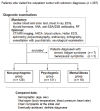Somatic symptoms with psychogenic or psychiatric background: Characteristics and pitfalls
- PMID: 34041115
- PMCID: PMC8138407
- DOI: 10.4103/jfmpc.jfmpc_1100_20
Somatic symptoms with psychogenic or psychiatric background: Characteristics and pitfalls
Abstract
Introduction: The characteristics of somatic symptoms seen at the first hospital visit in patients with psychogenic backgrounds remain poorly elucidated till date.
Methodology: A total of 277 patients who visited the Department of General Medicine at a single university hospital with somatic symptoms were prospectively enrolled in this study. The eventual definite diagnoses were classified into the following three groups: non-psychogenic disease (n = 128), psychogenic symptoms (n = 131), and mental illness (n = 18). Subsequently, the chief complaints and other background information of the patient obtained at the first visit were compared among the three groups.
Results: More than half of the patient with non-psychogenic diseases (60.2%) presented with a single complaint at their first hospital visit; contrarily, less than half of the patients with psychogenic symptoms (23.7%) or mental illnesses (22.2%) presented with a single complaint at the first visit. Approximately, <10% of the patients with non-psychogenic diseases had four or more multisystemic presentations at the first visit. The results of the receiver operating characteristic curve analysis revealed a fair discriminatory ability of the number of complaints to identify patients with psychogenic diseases or psychiatric backgrounds. Almost half of the non-psychogenic patients with four or more multisystemic presentations were eventually diagnosed with autoimmune-related disorders, such as Sjögren's syndrome or Behçet's disease. In conclusion, the general notion that patients with psychogenic somatic symptoms are likely to present with more complaints than patients with non-psychogenic diseases is correct. However, not a few patients who present with multiple indefinite complaints would certainly have organic diseases such as autoimmune-related disorders or neuromuscular diseases. A careful diagnostic process is required in such patients before attributing their symptoms to psychogenic or psychiatric factors.
Keywords: Chief complaint; mental illness; psychogenic; somatic symptom disorder; somatoform disorder.
Copyright: © 2021 Journal of Family Medicine and Primary Care.
Conflict of interest statement
There are no conflicts of interest.
Figures



Similar articles
-
Youth With Psychogenic Non-Syncopal Collapse Have More Somatic and Psychiatric Symptoms and Lower Perceptions of Peer Relationships Than Youth With Syncope.Pediatr Neurol. 2018 Feb;79:34-39. doi: 10.1016/j.pediatrneurol.2017.11.009. Epub 2017 Nov 20. Pediatr Neurol. 2018. PMID: 29241946
-
[Psychiatric manifestations of lupus erythematosus systemic and Sjogren's syndrome].Encephale. 2001 Nov-Dec;27(6):588-99. Encephale. 2001. PMID: 11865567 French.
-
[Phenomenology and psychiatric origins of psychogenic non-epileptic seizures].Srp Arh Celok Lek. 2004 Jan-Feb;132(1-2):22-7. doi: 10.2298/sarh0402022r. Srp Arh Celok Lek. 2004. PMID: 15227961 Serbian.
-
[Psychogenic non epileptic seizures: a review].Encephale. 2011 Apr;37(2):153-8. doi: 10.1016/j.encep.2010.04.009. Epub 2010 Jul 1. Encephale. 2011. PMID: 21482234 Review. French.
-
The problem of psychogenic symptoms: is the psychiatric community in denial?Epilepsy Behav. 2005 Feb;6(1):9-14. doi: 10.1016/j.yebeh.2004.10.009. Epilepsy Behav. 2005. PMID: 15652726 Review.
Cited by
-
Factors related to the occurrence of mass psychogenic illness in schools: a systematic review.Soc Psychiatry Psychiatr Epidemiol. 2025 Jun 19. doi: 10.1007/s00127-025-02949-6. Online ahead of print. Soc Psychiatry Psychiatr Epidemiol. 2025. PMID: 40537604 Review.
References
-
- Kurlansik SL, Maffei MS. Somatic symptom disorder. Am Fam Physician. 2016;93:49–54. - PubMed
-
- American Psychiatric Association. Diagnostic and statistical manual of mental disorders. 5th ed. Arlington: American Psychiatric Association; 2013.
-
- Toussaint A, Hüsing P, Kohlmann S, Löwe B. Detecting DSM-5 somatic symptom disorder: Criterion validity of the Patient Health Questionnaire-15 (PHQ-15) and the Somatic Symptom Scale-8 (SSS-8) in combination with the Somatic Symptom Disorder-B Criteria Scale (SSD-12) Psychol Med. 2020;50:324–33. - PubMed
LinkOut - more resources
Full Text Sources
Other Literature Sources
